Rose Munstead wood
Avid rose growers have long heard about the wizard David Austin, the creator of extraordinary English roses. Despite the fact that in the official classification of the group "English rose" does not exist, the number of such varieties and their popularity are increasing due to the exquisite forms and aroma of flowers. One of the wonderful creations of the master was the beautiful Manstead Wood, who conquered rose growers with the depth of color and velvety petals.
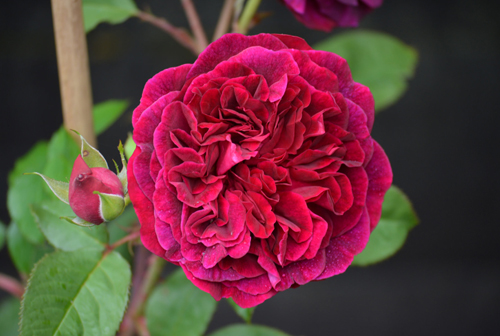
History of creation
This exquisite variety with the charm of an old rose was introduced to the rose-growing world in 2007. Selected by David Austin. 2 generic varieties of Rosa hybrida were crossed as parental forms. The novelty belongs to scrubs, that is, it is a shrub plant. Exhibition name - Munstead Wood. The registration unique name is AUSbernard. In the United States, the cultivar was registered as Munstead Wood in 2010. The unusual name of Manstead Wood is actually the name of a unique park at the home of the famous gardener Gertrude Jekyll in Surrey. She became widely known in England and throughout the world as a theorist and practitioner of garden art.
Awards
The Royal Horticultural Society highly appreciated the novelty. But the beautiful rose has earned not only praise, but also an award. Readers of the French magazine Rustika in 2009 unanimously recognized Munstead Wood as the flower of the year. In 2011, the Japan Rose Society awarded our heroine a gold medal in the category "For aroma." In the same year, the variety won the Portland's Best Rose Contest for Best Shrub Class, held in the USA.

Description
The plant is upright, 80 - 100 cm high, moderately spreading shoots forms a bush with a diameter of 60 cm. General impressions - a compact, well-leafy shrub. The shoots are strong, however, young branches during the flowering period can droop under the weight of flowering buds. Good branching, very thorny shoots. The spines on adult shoots are rather large. The young leaves of Manstead Wood are red-bronze in color, making a beautiful contrast to the flowers. The mature leaves are medium in size, bright green, with a smooth, matte surface. Shoots are crowned with clusters-inflorescences of 3 - 5 buds.
The buds are round-ovoid, small, light crimson. When they open, they look like old roses. The shape of the flower is unusual, the inner petals form a round-cupped shape, and the outer ones are elegantly bent back. Over time, the rosette becomes more open, showing the middle with yellow stamens. Petals with wavy edges. Colors of incredible beauty and depth. The outer side of the petal is crimson, but the inner one is very dark, playing with burgundy-purple velvety tints. The color is influenced by temperatures, in summer the petals look brighter, but with the arrival of cold weather they acquire a deeper dark color, almost purple. The rosette is well filled, densely doubled, and consists of 70 - 75 petals. Diameter 8 - 10 cm.
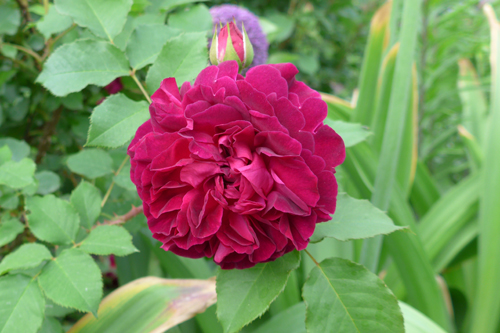
Flowering period
The beautiful Manstead Wood is a re-flowering one. Rose growers note that flowering occurs almost continuously under favorable conditions. The noble plant blooms very early. On adult bushes, inflorescences appear throughout the season, and our heroine works until the very cold. The bud opens slowly, but does not last long in full dissolution, about 3 days, sometimes a little longer. Faded rose inflorescences must be removed in a timely manner, without waiting for shedding, in order to enable the plant to redirect its forces to the formation and opening of new buds. One of Austin's main ideas was to bring back the flavor of the culture. And our heroine fully justified the hopes of her creator, becoming one of the most fragrant varieties created by the breeder. She has a rather strong classic aroma, enchanting, complemented by warm fruit and berry notes of blackberries and blueberries.
Characteristics
- Munstead Wood blooms the next year after the autumn planting.But you can appreciate the decorativeness of the shrub and enjoy the friendly flowering only in the 3rd year of its life;

- the variety is recommended to be grown in USDA Zone 6 (USDA system), which corresponds to -23.3 ° C in winter. But there is information that the variety is doing well in zone 4 (Moscow and Nizhny Novgorod), where the temperature in winter can drop below -30.0 ° C. True, in order to ensure a problem-free winter for the rose, you still have to build a shelter;
- Manstead Wood's immunity is average, but this is not at all a bad indicator. In general, with decent care, our heroine is quite resistant to fungal diseases - powdery mildew and black spot. But problems can arise in unfavorable years;
- the rosette is quite shade-tolerant, and as rose growers noticed, in partial shade, the flowering turns out to be the most lush, long-lasting and deeper in color;
- good heat resistance is also noted, the flowers do not burn in the sun, however, they fade faster. But, despite the heat, the bush continues to form new buds;
- resistance to rain is not bad, given the dense doubledness of the outlet. Small rains will not do much harm, only some flowers may be damaged. Even young plants tolerate wet weather without any problems. But during the period of prolonged rains, the flowers that have gained moisture become soaked and wilted, and the buds may not open at all;
- according to reviews, the variety tolerates transplantation well.
Planting and leaving
Planting Manstead Wood is possible in the fall and spring. Light, nutritious soils are preferred. If there is heavy clay soil on the site, then a larger hole is dug in order to lay drainage on the bottom and fill with suitable soil. In leaving, the beauty is not picky, she is quite satisfied with the usual agricultural technology for the culture as a whole. But care should not be neglected. Even in favorable years, preventive spraying against fungal diseases should be carried out, and in between flowering, the rose must be fed. For planting, a site is more suitable where the velvety petals will be saved from the midday heat by diffused partial shade. The variety propagates very easily - with the help of cuttings. In cool regions, it is advisable to install a frame above the bushes and cover it with a non-woven covering material that easily allows air to pass through. Our heroine feels great not only in the role of a garden plant, but also as a pot culture.
Rose growers like the amazing Munstead Wood very much, it is not for nothing that many of them dream of getting it into their collection. But you should beware of re-grading, when purchasing a plant, be careful. This variety will delight you with its unpretentiousness, simplicity of agricultural technology, and most importantly, the exquisite charm of old roses with a wonderful aroma. The darkest, but at the same time the most beautiful of the Ostins, Manstead Wood can act as a single flower bed decoration, framed by a neat green lawn. It goes well with a variety of colors, therefore it is used in group compositions. There is still a drawback to this piece of rose-growing art - a too thorny bush, and this, of course, interferes with the process of caring for it.

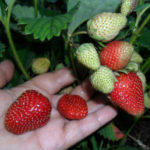
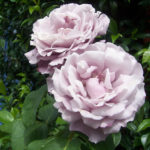


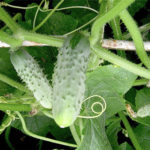



I love this rose very much - it has such a rich color of petals that I have never seen in any other variety. At the beginning of the dissolution, the buds are the color of "boiled beet", then the petals brighten a little. Unfortunately, the opened flowers do not last long and fly around for 3 - 4 days, but on the other hand, this is good - the roses do not have time to lose their stunning shade.The variety also has a wonderful "pink" aroma - it is strong, but not cloying at all. The health of the variety, however, is not very good - it often picks up fungal infections, but with age, resistance increases markedly. But the rose always hibernates perfectly - I would say that it is unkillable.